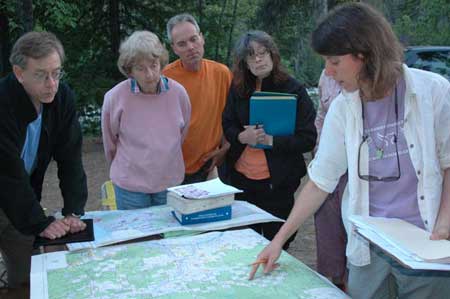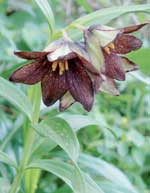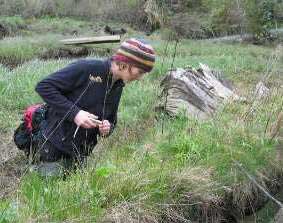|
Facts & Figures: Rare Plant Care & Conservation
 |
| Rare Care Program Manager Wendy Gibble,'06, far right, discusses Silene seelyi locations with volunteers, from left: Jeff Thorson, Wendy McClure, Rod Gilbert and Julie Bresnan.* |
- The Rare Plant Care and Conservation Program (Rare Care) at the UW Botanic Gardens is the first plant conservation program focused exclusively on vascular plants designated as rare in Washington state. Native plant species in Washington are being threatened by rapidly-growing human population and development, and currently, 350 plant species are considered to be sensitive, threatened or endangered in the state.
-
Launched in 1998 by Professor and Interim UW Botanic Gardens Director Sarah Reichard within a year of her appointment to the SFR faculty, the program focused on research for the first couple of years. Graduate students studied various aspects of native plant species that were at risk in Washington, including the effects of recreational climbing on Seely’s Catchfly (Silene seelyi), propagation techniques for golden paintbrush (Castilleja levisecta) and factors affecting the rarity of Wenatchee Mountains checker-mallow (Sidalcea oregana var. calva).
-
The vision for the program expanded to develop a community of undergraduate students, graduate students and volunteers working on a daily basis towards rare plant conservation in Washington. The program now incorporates both on-site (in situ) and off-site (ex situ) methods of conservation.
 |
| Black lily (Fritillaria camschatcensis) is listed a sensitive species by the Washington and Oregon Natural Heritage Programs. |
-
In 2001, the program expanded substantially with the launch of the rare plant monitoring project, under the direction of Laura Zybas, ’00. Zybas investigated other rare plant monitoring programs and adopted approaches to ensure that the program delivers high quality data and that the location of rare plant populations is kept confidential. Volunteers are a key component of the monitoring program, and since 2001, Rare Care has trained over 350 volunteers statewide. The program has become one of the largest of its kind in the nation, and since its inception, volunteers have contributed over 20,200 hours and are located throughout Washington and northern Oregon. Volunteer work has resulted in 1,000 reports to the WA Department of Natural Resources’ Washington Natural Heritage Program on the status of populations of more than 190 species of rare native plants.
-
While it is always preferable to conserve and protect species by preserving their native habitat, there is an increasing realization that off-site conservation is also needed. In 2003, with a grant from the Miller Charitable Foundation, Rare Care initiated its ex situ program with construction of the Miller Seed Vault at the UW Botanic Gardens Center for Urban Horticulture. Today the vault holds seeds of 83 species of rare native plants. It is also used for short-term storage of native seeds for restoration and research.
-
Rare Care’s 2010 Annual Report records that last year 106 volunteers devoted 3,350 hours to rare plant monitoring during the 2010 field season, and trained 31 volunteer monitors in sessions conducted in Seattle, Twisp and Wenatchee. During the 2010 field season, seven volunteers devoted 206.5 hours to complete 19 seed collections. This includes time spent in preparation and planning, field work and report writing. In addition, 11 volunteers contributed 160.25 hours of time cleaning and packaging seeds for long term storage in the Miller Seed Vault.
 |
| Alaine Sommargren, ’08, counts black lily (Fritillaria camschatcensis) individuals in a Washington estuary for her master’s thesis. |
- Rare Care assists several state and federal agencies, including the Washington Department of Natural Resources, the USDA Forest Service, and the Bureau of Land Management, with rare plant monitoring and collection across the state. In 2004, the program received a joint Conservation Project Award from the Forest Service and the Bureau of Land Management in recognition of its outstanding accomplishments for conserving native plants and their habitats on public lands. Then-Program Manager Carolyn Alfano, ’00, ’02, accepted the award from the Bureau of Land Management director and the Forest Service chief in March 2004 at a ceremony in Spokane, Wash. Currently, Rare Care is working with the National Park Service to conserve rare alpine plants in Olympic, Mount Rainier and North Cascades National Parks that may be vulnerable to global climate change.
-
Says Rare Care Director Reichard, "Priorities for the coming years include the need to remain focused on our mission but adaptable in its execution so that we can respond to a rapidly changing world. Ex situ collection will play an increasingly important role in the future as we begin to grapple with climate change effects."
-
Adds Program Manager Wendy Gibble, ’06: "Rare Care is a great example of a successful ‘citizen science’ program—built on a solid framework of scientific inquiry and comprehensive training, and providing critical information for environmental planners and policy makers in Washington."
-
For information on how you can be involved, whether as a volunteer or a supporter of field monitoring or ex situ conservation, visit the Rare Care website.
* Photo by Jennifer Youngman
|

